Real Madrid are having a tough season after winning La Liga in 2020. Their policy of recruiting young and promising players hasn’t delivered the expected results with the likes of Éder Militão, Luka Jovic, Vinicius Junior, Martin Odegaard or Rodrygo failing to become regular starters so far. This has led Real Madrid to use almost the same core of players who won the UEFA Champions League three times in a row between 2016 and 2018, but these players are getting older and their replacements don’t seem to have the level required to fill their void in the short term.
In this kind of situation, turning to academy players is a natural and cost-effective reaction for clubs. Real Madrid have seven U25 players in their first team and none of them is 100% an academy product, with Federico Valverde being the only one we could consider as an academy graduate even if he signed for Real Madrid when he was 18. From the eight academy players who have made their La Liga debut in the last five years, only the three most recent ones are still at the club, showing how the club is failing to produce talents who can settle in the first team.
In this data analysis, we will take a look at Real Madrid’s B team, Castilla, to see which defenders are showing potential competing in Segunda B (Spanish third division) and could be ready to make their move to the first team soon. With Marcelo declining game after game and Sergio Ramos’ future in the air, Real Madrid could look at their academy to find cheap solutions in these uncertain times.
Methodology
This is a short and concise data analysis on Real Madrid Castilla’s goalkeepers, centre-backs and full-backs, comparing them to all the players in Segunda B and seeing which players stand out and could potentially contribute in La Liga. Keep in mind there are 102 teams in Segunda B this season and it’s a senior and professional league so standing out here means the young players are ready to play at a higher level of senior football.
In each position, we have used scatter plots with different relevant statistics (data taken from Wyscout) to compare players in the selected position. We’ve only considered players who have played at least 400 minutes in the current season to avoid non-significant results. Real Madrid Castilla’s players are marked in red in each graph.
Each scatter plot has two grey areas between the 25th and the 75th percentile, meaning 50% of the players are inside that area. Players outside the grey area in the top or bottom 25% of the selected metric and it makes it easier to visualize how much did a player stand out.
In order to cover the three positions in a single analysis piece, each separate analysis is just a first approach and it would require further data analysis to make a decision. There will be a second data analysis covering midfield and attacking players.
Goalkeepers
Real Madrid have Thibaut Courtois as their clear first-choice goalkeeper with the 22-year-old Ukrainian Andriy Lunin as his backup. They seem to trust Lunin a lot and at the moment there aren’t any issues here as Courtois should have at least four or five years left at the highest level.
Toni Fuidias is the only goalkeeper who has played more than 400 minutes for Real Madrid Castilla this season so he’s the only one we’re considering in this analysis but they have used two other goalkeepers and the position doesn’t have a clear pick.
In the graph below, we see two of the most important statistics to evaluate goalkeepers: goals avoided per 90 (expected conceded goals minus conceded goals, y-axis) and save rate (x-axis).
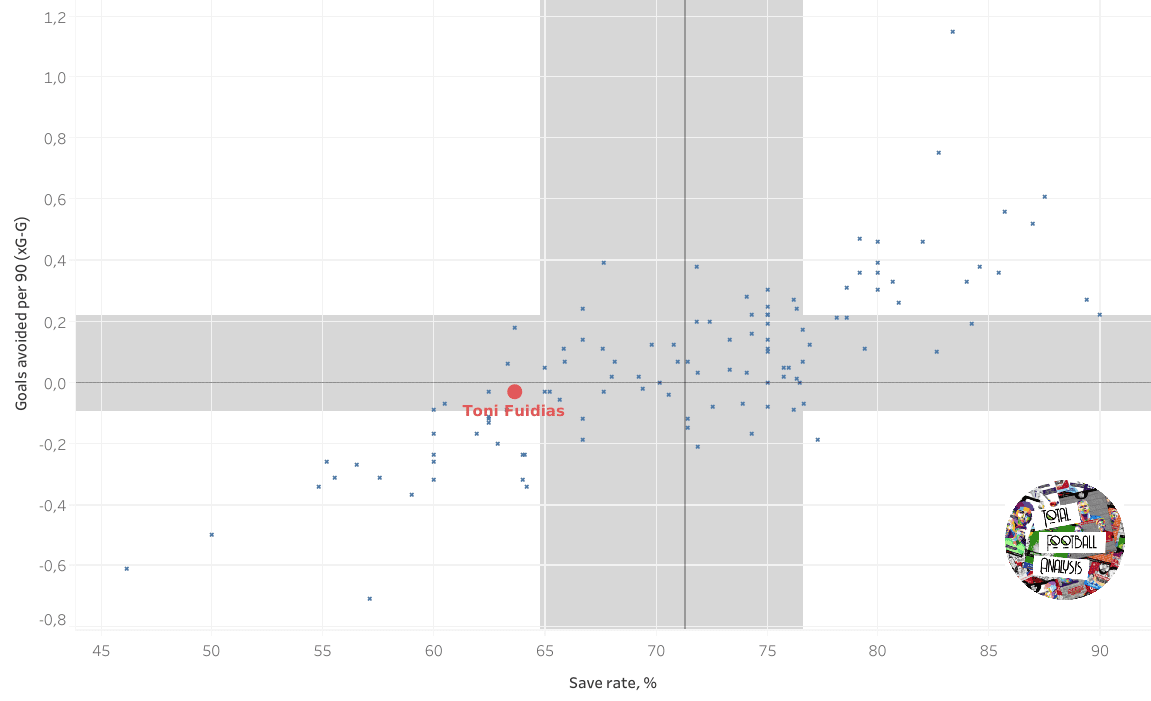
Fuidias doesn’t rank very well in either metric, conceding 0.03 goals more than he should and ranking in the bottom 25% for save rate with 63.64%, well below the average of 71.3%. He’s still 19 and goalkeeper is a very age-sensitive position but he doesn’t seem to be ready to compete with Lunin for the second goalkeeper position in the first team.
Just to add some context and compare, Iñaki Peña, the 21-year-old Barcelona B goalkeeper, has avoided 0.75 goals per 90 and his save rate is 82.76%, well over the average in both statistics. It seems like Fuidias is still some way from making an impact at a higher level.
Full-backs
The full-back position has been one of the most discussed at Real Madrid this season. Marcelo is declining and Ferland Mendy is the current starter on the left but his profile is very different from the Brazilian’s, especially regarding his creativity in attack. On the right side, Dani Carvajal is the clear starter but he has missed 18 matches so far this season. Álvaro Odriozoola, his natural replacement, isn’t trusted by Zidane who has preferred to play Lucas Vázquez or Ferland Mendy out of position on the right side of the defence. In this context, Real Madrid should be interested in looking at their academy for possible solutions to complete their squad.
Four Real Madrid Castilla full-backs have played more than 400 minutes so far this season: Miguel Gutiérrez (2001) and Alberto Retuerta (2002) on the left and Sergio Santos (2001) and Guillem Rodríguez (1998) on the right. They are the candidates to compete in both full-backs positions in the first team and the protagonists of this section of the data analysis.
First, we’ll look at these full-back’s defensive contribution. To evaluate this, we have selected two statistics: successful defensive actions per 90 (y-axis) and defensive duels won % (x-axis). The former metric gives us a good grasp of how involved the full-back is in defence and how many times he succeeds per 90, with the second being more specific and focusing on individual duels.
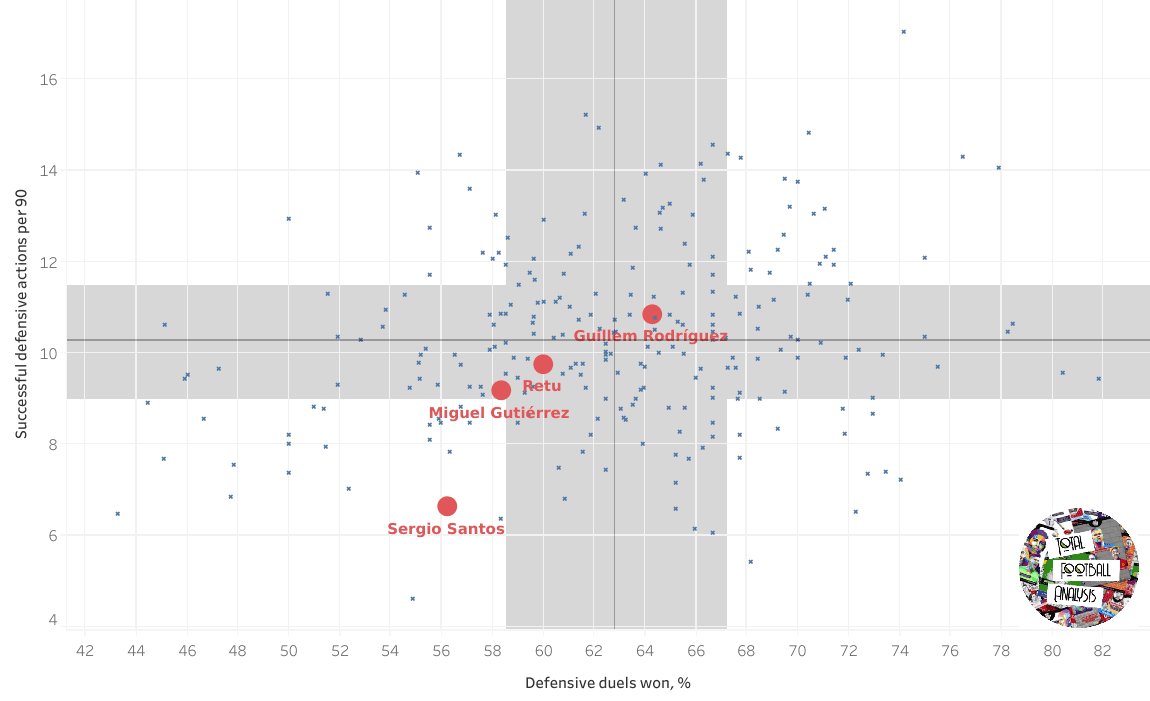
The first conclusion we make from this is that Santos has a lot of room for improvement on the defensive side of his game. He’s in the bottom 25% for both selected metrics compared to every other full-back in the league. His young age (20) means he still has time to become a tougher right back but he doesn’t seem ready to take defensive responsibilities at a higher level at the moment.
The other three full-backs are decent defenders, ranking between the 25th and 75th percentiles in both metrics. Guillem Rodríguez (left-back) ranks above average in both metrics and seems like the most solid defender of the three but he’s already 22 and he doesn’t seem to have a long-term future at the club as he has never been a regular starter for Real Madrid Castilla and has only started 42% of the matches this season.
Both left-backs, Retu and Miguel Gutiérrez (both 19), rank around the average in both metrics and seem more ready to play at a higher level. They’re still very young but putting those numbers in a tough league as the Segunda B is quite impressive and a signal of their potential.
Next, we’ll look at these full-backs’ offensive contribution. The chosen metrics are expected assists per 90 (y-axis) as a way of measuring their end product and ability to create good chances and successful attacking actions per 90 (x-axis) as a more general measure of their contribution to their team’s attack.
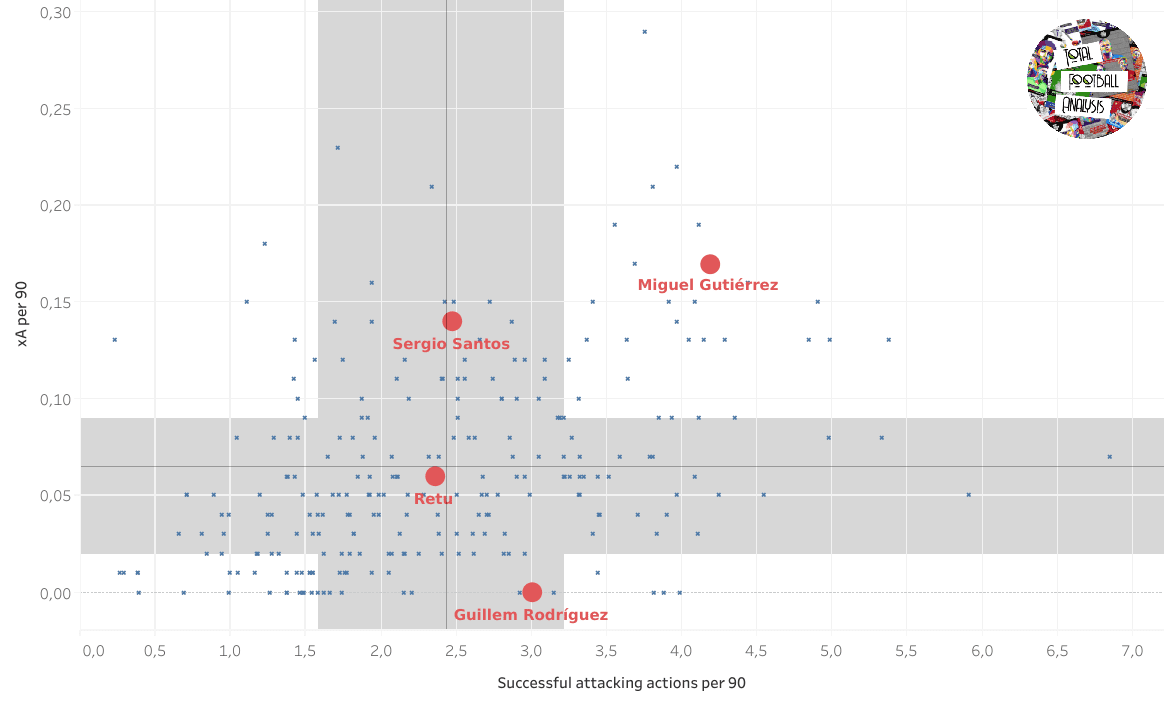
Miguel Gutiérrez is the clear winner here. He ranks in the top 25% in both metrics with 0.17 xA and 4.19 successful attacking actions per 90. This means he’s a highly productive and complete player in attack, being in the top 25% of the league also in dribbles (3.39 per 90), crosses (4.19 per 90), key passes (0.6 per 90), progressive runs (2.79 per 90) and even xG (0.15 per 90).
Gutiérrez’s impressive attacking stats from the left-back position combined with his decent defensive level makes him one of the most interesting players in Real Madrid’s academy. He was on the bench against Getafe in the last match and his debut shouldn’t be far away, especially considering Zidane’s new 3-man defence, which allows him to play Mendy as a centre-back paired with a very offensive left-back, and Marcelo’s most recent injury.
For the other three, Santos has an average involvement in attack but is highly effective at creating chances with 0.14 xA per 90. Anyway, we’ve seen he’s not the most reliable in defence so it seems difficult for him to get an opportunity in the first team until he improves this. Retu ranks again very close to the average in both metrics, showing he’s a balanced but unspectacular full-back, while Guillem Rodríguez does have the quality to progress, ranking among the best full-backs in passes to the final third (8.73 per 90) and progressive passes (11.44 per 90), but his end product is the worst of the three and he struggles to make an impact in the final third.
In this section of the analysis, Miguel Gutiérrez was the player who stood out the most and he should be considered for further analysis. He’s performing very well for Real Madrid Castilla and should be a long-term project for the club if he continues his progression.
Centre-backs
The middle of the defence is another position where Real Madrid have had problems this season. They haven’t found any reliable option to substitute Sergio Ramos when he’s not available, with Militão struggling to justify his price tag, Varane dropping his form when not playing with Ramos and Nacho being just an emergency solution.
In their second team, Real Madrid have used only two centre-backs for more than 400 minutes: Víctor Chust, usually on the left side, and Mario Gila, usually on the right. Both of them are 20 years old. The former has already made his first-team debut, being part of the team that lost to Alcoyano in the cup while the latter is still waiting for an opportunity.
In the first team, and especially in the absence of Ramos, great defensive abilities are required, so we’ll start the analysis of these centre-backs with their defensive performance. We have chosen the success rate in defensive duels (y-axis) and aerial duels (x-axis) as the quickest way of evaluating defensive performance.
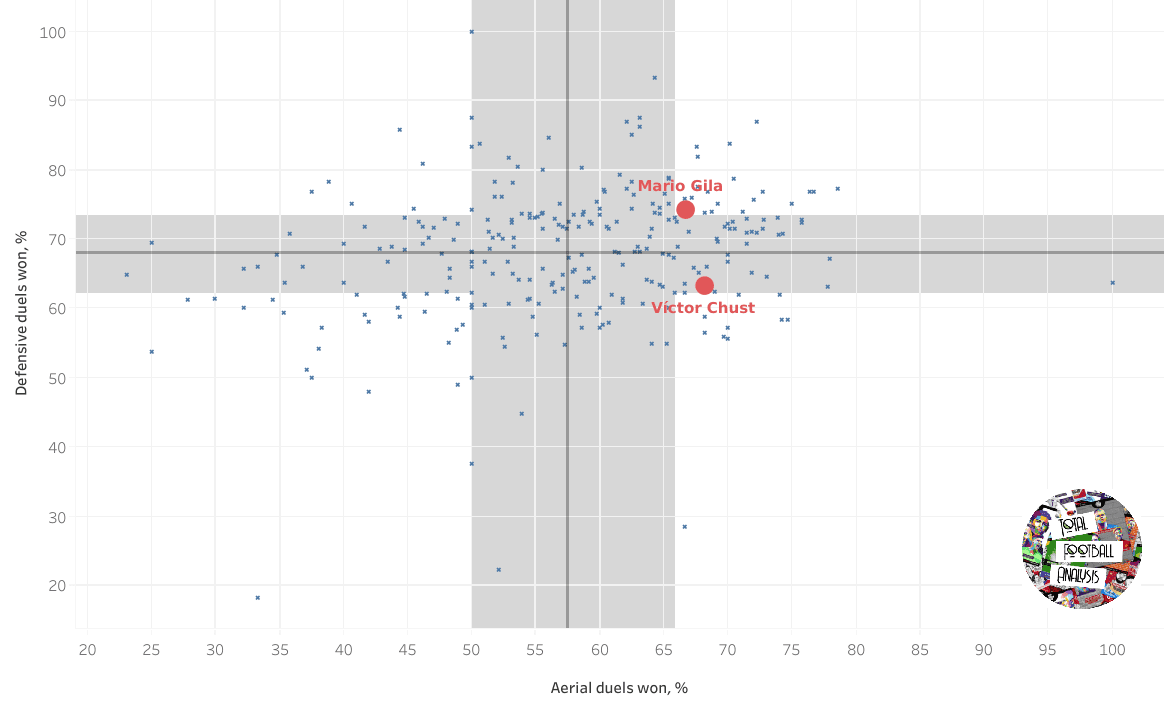
This graph shows how difficult it is to stand out from the crowd as a centre-back as 50% of them win between 62.26% and 73.52% of their defensive duels or between 50% and 65.9% of their aerial duels. Having this in mind, Mario Gila’s position in the top 25% in both metrics with a success rate of 74.19% in defensive duels and 66.67% in aerial duels is very impressive.
Víctor Chust also ranks quite well, with an above-average 68.18% success rate in aerial duels and a decent 63.13% success rate in defensive duels, very close to the average 67.95% average.
This data shows both centre-backs are good at this level, with Chust being slightly better in the air but Gila being better on the ground. Real Madrid Castilla try to play attacking football (their average possession is 56.6%, 12th out of 102 teams) so both Gila and Chust are involved in fewer duels than other centre-backs. This situation would be the same in the first team (59.1% average possession, third in La Liga) so they shouldn’t find it difficult to adapt.
In the next graph, we see their contribution to progress from the back and establish the team in the opposition half. Again, this is a very demanded quality in modern centre-backs, and being excellent on the ball can make up for not being an excellent defender in some tactics. In the y-axis, we see progressive runs per 90 and in the x-axis, progressive passes per 90.
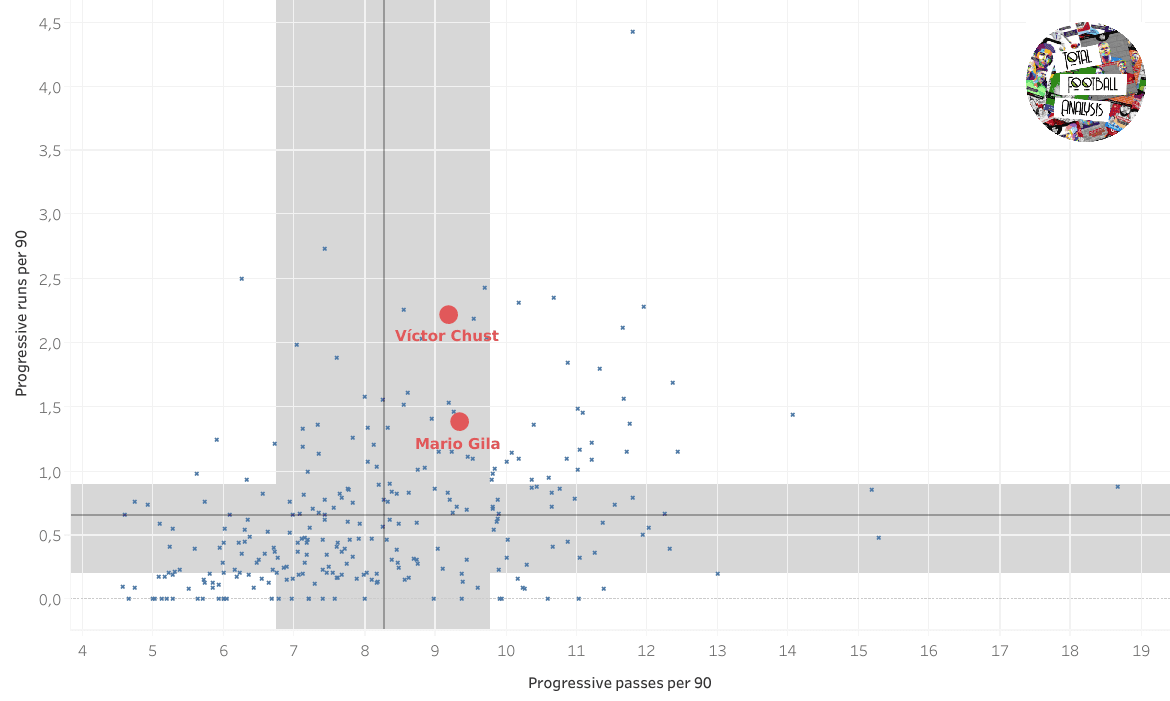
Both Real Madrid Castilla centre-backs rank very well in both metrics. They are in the top 25% for progressive runs per 90 (Chust 2.22 and Gila 1.38) and above average in progressive passes per 90 (Chust 9.19 and Gila 9.34). When looking at more attacking statistics, we see that both Chust and Gila rank in the top 25% of the league in passes per 90 (62.34 and 60), passing accuracy (89.09% and 76.92%) and passes to the final third per 90 (9.51 and 8.88).
Real Madrid Castilla players are used to being pressed very aggressively and intensely. They face an average PPDA (passes per defensive action) of 12.8, the sixth-highest of the 102 teams in the league and very similar to the first team, that face an average PPDA of 15.8, the third most out of the 20 La Liga clubs.
Gila and Chust are a very balanced and complementary centre-back pair. They rank well or very well in all important metrics, with Gila being slightly better in defence and Chust in attack. This season, Real Madrid have needed to replace Ramos most of the time, so it’s normal they chose Chust because of his ball-playing abilities and also because he’s used to playing as a left centre-back. But it wouldn’t be surprising if Gila also gets his opportunity soon as he’s performing at a similar level and could also be a long-term asset for the club.
Conclusion
Replacing some of the all-time best players like Ramos and Marcelo is a titanic task. Real Madrid have opted to sign young and promising players to renew their squad but it hasn’t worked out as they expected in defence. Militão looks too far from replacing Ramos and Mendy has a completely different playing style to Marcelo’s.
The current financial situation will surely encourage Real Madrid to make the most out of their current resources and that includes their academy. Players like Víctor Chust, Mario Gila and Miguel Gutiérrez have shown they are ready and deserve an opportunity at the first team as they can bring what other signings have failed to.
Only time will tell if these or other academy players step into the boots of Ramos, Marcelo and company or if they leave the club after showing promising things in the first team as it happened to Sergio Reguilón, Achraf Hakimi or Theo Hernández. Anyway, Real Madrid are a smart club so they’ll surely take advantage of the talent they produce, be it using it in the first team or getting a good transfer fee for them.





Comments